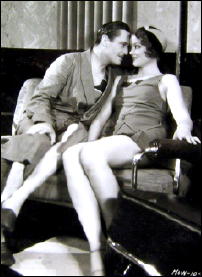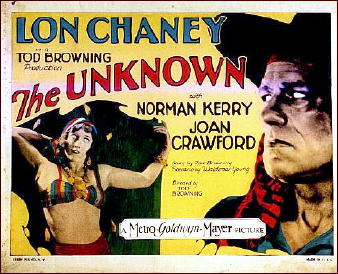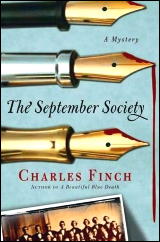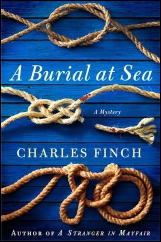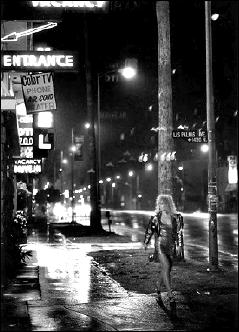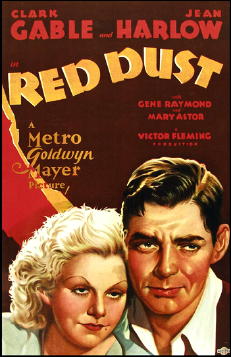October 2011
Monthly Archive
Fri 28 Oct 2011
A REVIEW BY RAY O’LEARY:
ELIZABETH LEMARCHAND – Who Goes Home? Walker, US, hardcover, 1987. No US paperback edition. UK edition: Piatkus, hardcover, 1986.

Vacationing Chief Superintendent Tom Pollard and his wife go hiking through the Crownmoor District and, while resting near a dilapidated farmhouse, see it visited by a young man who, finding no one home, soon leaves.
The next night, the house is heavily damaged by a fire of suspicious origin. Shortly afterward, someone is killed in a hit-and-run accident, carrying drugs and a map to the farmhouse. Police, digging through the rubble for more information, discover a twenty-year-dead skeleton, and Scotland Yard — meaning Pollard and his assistant Inspector Toye — is called in.
The trouble with this one, besides the fact that none of the characters show any sign of life, is that I guessed the identity of the skeleton’s original owner almost as soon as it was dug up. Add to this massive doses of coincidence used to help Pollard solve the case, and you have what Mystery Aficionados refer to as a Real Clunkeroo.
ELIZABETH LEMARCHAND. 1906-2000. Series Character: Insp./Supt. Tom Pollard in all.
* Death of an Old Girl, 1967.
* The Affacombe Affair, 1968.
* Alibi for a Corpse, 1969.
* Death on Doomsday, 1971.
* Cyanide with Compliments, 1972.
* Let or Hindrance, 1973.
* Buried in the Past, 1974.
* Step in the Dark, 1976.
* Unhappy Returns , 1977.
* Suddenly While Gardening, 1978.
* Change for the Worse, 1980.
* Nothing to Do with the Case, 1981.
* Troubled Waters, 1982.
* The Wheel Turns, 1983.
* Light Through Glass, 1984.
* Who Goes Home?, 1986.
* The Glade Manor Murder, 1988.
Previously on this blog: Suddenly While Gardening (reviewed by Steve Lewis)
Thu 27 Oct 2011
Posted by Steve under
Reviews[8] Comments
Reviewed by RICHARD & KAREN LA PORTE:
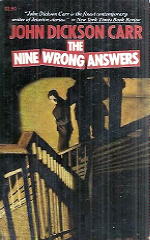
JOHN DICKSON CARR – The Nine Wrong Answers: A Novel For The Curious. Carroll & Graf, paperback reprint, 1986. Hardcover edition: Harper & Brothers, 1952. Also reprinted in paperback by Bantam: 1955 (shown), 1962.
In this tightly wound tale of impersonation, fortune hunting, heir baiting and generally obnoxious skulduggery, John Dickson Carr intersperses the text with nine answers to questions that might lie in the mind of the justly suspicious reader. Each step in this carefully choreographed cat-and-mouse ballet leads the reader into another intellectual pitfall.
Bill Dawson, down on his luck in New York, falls into a proposition that he can’t say no to. He will, for a fee of $10,000, return to England as Laurence Hurst, heir to a considerable fortune from his doddering uncle Gaylord Hurst. The only catch to this game is that Dawson must call weekly on Uncle Gay and be a proper nephew and heir.
The switch in identities is quickly made and Dawson is on his way to England. He isn’t even across the briny when his ex-flame Marjorie Blair insinuates herself into the adjoining seat and into his plans by unmasking him without a moment’s hesitation.
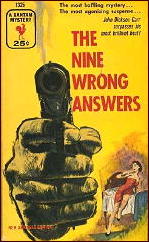
If she can spot his deception, how long will it take for Uncle Gay to penetrate the disguise and turn his sadistic manservant loose? When this comes true, the cat-and-mouse game starts. Bill “Larry Hurst” Dawson will inherit nothing, unless he outlives Uncle Gay and Uncle Gay swears that Dawson won’t live out the week. THE GAME IS AFOOT!
The Nine Wrong Answers is a Sherlock Holmes buff’s treasure. Not only is the great detective cited as an authority on many of the points raised in the pursuit of truth in this tale but one of the final scenes takes place in and around the Sherlock Holmes sitting room prepared for the 1951 Exhibition in Baker Street.
As ever, Carr’s characters are complex and well developed and the plot is sufficiently convoluted to test the wits of the most sophisticated reader. This book has been too long out of print. We welcome it back as a classic “MUST” on everyone’s list.
— Reprinted from The Poisoned Pen, Vol. 7, No. 1, Fall-Winter 1987.
Thu 27 Oct 2011
REVIEWED BY DAN STUMPF:
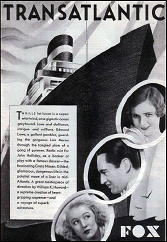
TRANSATLANTIC. Fox, 1931. Edmund Lowe, Lois Moran, John Halliday, Greta Nissen, Myrna Loy, Jean Hersholt. Oscar, Best Art Direction: Gordon Wiles. Director: William K. Howard.
Just lately I’ve been catching up to a lot of films I’ve wanted to see — or see again — for quite some time, films lost or just unavailable for a generation or more. First and best of the bunch is Transatlantic, which I’ve been keen to watch ever since I saw a still from it in a book on Hollywood Cameramen thirty years ago.
Made at the dawn (or early morning anyway) of talking pictures, Transatlantic defies every notion you ever had about early talkies; it’s a fast-paced, highly visual thriller, set on a luxury liner with a clever story (by Guy Standing, whose credits include the book for Anything Goes) centered around Edmond Lowe as a shady character fleeing the law, mingling aboard ship with con men, kept women, and the loyal trophy wife (Myrna Lay, back when she usually played oriental temptresses) of a nearly murdered millionaire — who apparently ran a bit of a con himself.
Director William K. Howard and photographer James Wong Howe take this snappy mystery and serve it up with splendid sets that give the huge ship the appearance of a Byzantine palace or gothic cathedral, jazzed up with snappy editing and a restless, roving camera that follows the action perfectly. All capped off very effectively by a tour-de-force cat-and-mouse shoot-out in the labyrinthine guts of the ship itself.
Simply dazzling. Not a well-known film, but one I can recommend highly.
Mon 24 Oct 2011
REVIEWED BY WALTER ALBERT:
THE UNKNOWN. MGM, 1927. Lon Chaney, Norman Kerry, Joan Crawford, Nick De Ruiz, John George. Director: Tod Browning.
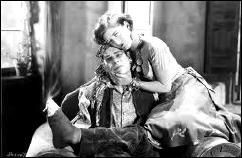
One of Lon Chaney’s most famous roles. He plays Alonzo, an armless circus performer, who loves Manon (Joan Crawford), daughter of the circus owner. Alonzo performs prodigious feats with his bare feet and is caressed fondly by Crawford, who cannot bear to be touched by “normal” men.
Eventually, Crawford is cured of her neurosis and is happily married to the strongman, who has devised an act where his arms are attached to two horses running in place on treadmills with the mechanism controlled by a single lever in the wings.
Alonzo, insane with jealousy, gains control .of the lever and, as a horrified Crawford watches, speeds up the treadmill, the horses straining at their ropes, so that…
But you didn’t think I was going to tell you how this one came out, did you?
There’s a strangulation, murder, a dwarf, a visit to a hospital operating room at midnight (this is, after all, only four years before Frankenstein), and Chaney’s menacing, brooding presence, like a tightly-wound spring that threatens to unwind at any time.
— Reprinted from The MYSTERY FANcier, Vol. 8, No. 4, July-August 1986.
Mon 24 Oct 2011
Posted by Steve under
ReviewsNo Comments
THE ARMCHAIR REVIEWER
Allen J. Hubin
BILL PRONZINI – Jackpot. Delacorte, hardcover, March 1990. Dell, paperback, December 1990.
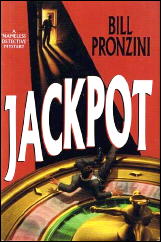
Bill Pronzini will find it tough indeed to top his scintillating 1988 “Nameless” novel, Shackles, and he doesn’t with the next, Jackpot, but by any other standard this is a very tasty morsel.
Nameless is still, months after his harrowing experiences in Shackles, undergoing anxiety attacks and learning new things — not all gratifying — about himself.
He needs to keep busy at work so his mind is distracted, and he takes on a nothing case as a favor to his friend Kerry. It seems that an otherwise very ordinary chap named David Burnett won $200,000 in a Lake Tahoe casino, then lost it all and more somehow, and committed suicide.
It’s very plainly suicide, but David’s sister doesn’t believe it, and Nameless, more as a comfort than anything else, agrees to check a few things. The more he checks, the more odor of fish turns up, and in due course it’s likely to be the stink of death, probably his.
Very smooth and observant narrative.
— Reprinted from The MYSTERY FANcier,
Vol. 12, No. 4, Fall 1990.
Mon 24 Oct 2011
IT IS PURELY MY OPINION
Reviews by L. J. Roberts
CHARLES FINCH – A Stranger in Mayfair. St. Martin’s/Minotaur Press, hardcover, November 2010; trade paperback, July 2011.
Genre: Historical mystery. Leading character: Charles Lenox; 4th in series. Setting: London, England-Victorian era.
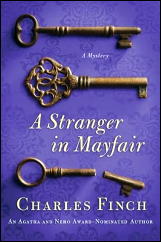
First Sentence: “Clara, who is that gentleman?â€
Charles Lenox has, at forty, entered a new phase in his life. He is newly married to Lady Jane, for years his best friend and neighbor, and he is newly elected to Parliament’s House of Commons.
The second of these events necessitates spending less time doing detective work — but not yet. A colleague in Parliament, Ludovic Starling, has asked Lenox to investigate the murder of one of his footman.
As Lenox, and his protégée Dallington, move forward in the investigation, they are met with resistance not only from Scotland Yard but from Starling, who asks them to give up the case. An attack on Lenox stiffens his resolve to find the killer.
Finch has become a favorite of mine and this book, once again, demonstrates why as there were so many levels on which I enjoyed this book.
We are introduced to Lenox and Lady Jane through a conversation held by others, via a prologue which actually works as it allows their back story to be told without it seeming forced or cumbersome. Each of the characters are fully drawn with very brief exposition that brings them to life.
One thing by which I am very impressed is how, with each book in the series, the characters lives individually grow and develop. This impacts not only each character but the relationships amongst them. Relationships are something Finch does extremely well, including the awkwardness of a newly married couple and a man making a major change in his career.
Mr. Finch’s knowledge of Victorian England is evident in every page and yet, again, so seamlessly incorporated into the plot that it is informative rather than intrusive. Through Lenox’s work in Parliament, we learn the concerns of the period and meet historical figures in their proper settings and appropriate roles. Through the birth of a child, we observe the customs and etiquette of the time.
Although Finch is American, he studied at Oxford, now lives in the UK and delightfully conveys British humor and understatement, “For an Englishman is was a strange time to be in France….first because of Napoleon’s rather uncouth attempt to conquer Europe…†The dialogue has a natural flow but also reflects the speech of the time.
Neither of the above is meant to devalue the plot. The mystery is intriguing, and full of effective twists. I like that solution is no more obvious to Lenox than to us, the reader. We are presented with numerous possibilities, each dismissed, until the final resolution.
Might I have figured it out? Perhaps; but the story involved me to the point where I wasn’t deliberately trying.
The only reason I did not rate the book as “excellent†was the use of portents which were completely unnecessary. Otherwise, I thoroughly enjoyed this book and highly recommend it with the proviso suggestion of starting the series at the beginning.
Rating: VG Plus.
The Charles Lenox Mysteries —
1. A Beautiful Blue Death (2007)
2. The September Society (2008)
3. The Fleet Street Murders (2009)
4. A Stranger in Mayfair (2010)
5. A Burial at Sea (2011)
Mon 24 Oct 2011
IMPULSE. 1990. Teresa Russell, Jeff Fahey, George Dzundza, Alan Rosenberg, Nicholas Mele, Lynne Thigpen. Director: Sondra Locke.

For the first thirty minutes of this movie, the type you’d see on late night cable, you’ll be tempted to dismiss this as just another “undercover-female-cop-with-an-attitude-problem” type of picture, but I think you’ll regret it if you turn it off too soon.
After the relatively slow beginning — brief bursts of action on the streets of Los Angeles, combined with a lot of talking about various problems, including brief glimpses of Lottie’s therapy sessions with the department’s resident psychologist – things pick up in a big way.
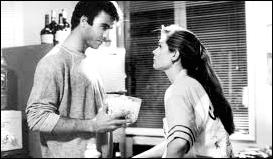
An undercover operation goes bad. There is a lot of shooting, and some guys dealing in drugs end up dead. Lottie is responsible for a couple of them. On her way home, she stops in a bar, she’s picked up by a guy with a billfold of $100 bills, and on impulse she goes to bed with him.
Which is when the real story begins. There are some small quirks of fate involved, a la Cornell Woolrich. and some giant-sized one. This movie is solidly in the pulp-oriented, hard-boiled tradition, but with a difference. The protagonist is female, and no shrinking violet.

Female, but aggressively active in the role, not passive, not a behind-the-back sort of manipulator. There are sane loose ends in the plot, I think, but in the final sixty minutes or so there’s one of the finer, more engaging mini-movies made recently that I’ve seen in a while. (There’s one well-behaved love scene, too, in which both participants seem to want to make the other party happy to be involved, as well as themselves.)
— Reprinted from Mystery*File 33, September 1991 (slightly revised).
[UPDATE] 10-24-11. I will have to see this movie again. I remember only parts of it, and I have a feeling that if I hadn’t read this review just now myself, I might not remember even those.
Reviews are IMDB are mixed. Those leaving comments are mostly positive, and those that are say very much the same sort of things as I did. The overall rating for the film is only 5.6 out of 10, though, which suggests the possibility that some viewers who watched saw the movie were looking for something else.
I also wonder if the fact that Impulse has a female director had more than little with the way it came out. (That’s a lie, actually. I’m not wondering.)
I wish I’d found a copy of the scene below in color, but perhaps in black and white it will enhance the movie’s (neo)noir credentials all the more:
Sun 23 Oct 2011
Posted by Steve under
Reviews[7] Comments
Reviewed by RICHARD & KAREN LA PORTE:
JOHN RHODE – The Claverton Affair. Dodd Mead, hardcover, 1933. Perennial Library, paperback, 1986. First published in the UK as The Claverton Mystery: Collins, hardcover, 1933.
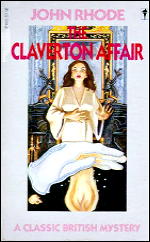
In this classic tale of crime and detection the scholarly Dr. Lancelot Priestley undertakes the solution of the untimely death of an old friend, Sir John Claverton.
The inquest rules it as death by natural causes (severe gastric ulcer-like internal damage) but Priestley feels that there are other factors involved. Sir John had just signed a new will that made radical changes in the disposition of his rather substantial estate.
The beneficiaries now include his estranged sister Clara Littlecote, her daughter Helen, a young cousin, Ivor Dunford; who is a chemist and, as an enigma, a Mrs. Muriel Archer and her daughter, a girl of fifteen.
John Rhode tells a penetrating story of greed, imposture and misdirection, reserving the final dismantling of the plot for a rigged seance to confront the villain with proof of his crime. Dr. Priestley’s rationalizations are fully explained at long and sometimes pedantic length but his careful attention to detail sifts the almost undetectable clues out until the killer’s fiendish method is disclosed.
Time and science have advanced a long way since this book was originally published in 1933, but the classic battle of wit and erudition does not suffer from a half century of progress.
— Reprinted from The Poisoned Pen, Vol. 7, No. 1, Fall-Winter 1987.
Editorial Comment: Richard and Karen La Porte were well-known mystery fans in the 1980s, and this issue of Poisoned Pen contains a dozen or more of their reviews.
I have editor-publisher Jeff Meyerson’s permission to reprint the reviews, which I think are well done, but I’ve no success in getting in touch with the La Porte’s themselves. The most recent Google reference to either of them is from the early 1990s.
Conferring with Jeff and several others who knew them, we’ve decided that they’d be pleased to see their reviews online. We hope we’re correct in choosing to do so. This one is the first, with more to come.
Sun 23 Oct 2011
L. L. ENGER – Swing. Pocket; paperback original; 1st printing, August 1991.

This is the second adventure of Gun Pedersen, a former baseball slugger who’s now a righter of wrongs, a Travis McGee type of non-PI, the kind of guy who you’d want on your side, one who sticks up for his friends. I haven’t read the first one, Comeback, but I have a copy, and I’m sure I’ll dig it out and read it one of these days.
Pedersen’s home is Minnesota now, and the scene makes several dramatic changes back and forth between the cold, ice-covered lakes of the North Country and the sunny climes of Florida, where a former teammate is trying to hang on in the Senior League.
Moses Gates is his name, and there’s always been a connection in his past with another ballplayer who once committed suicide (by hanging) during spring training. Now a reporter looking into the story is also dead, again by hanging, and Moses’ alibi looks awfully shaky.
This is a story far larger than life, and heads off in directions Gun hardly expects when he begins his crusade. (I didn’t expect them either, and I’m still a little amazed by it all.) There is far more action (of an extremely violent sort) than there is detection, but if that’s what you’re looking for, this is a story that will certainly get your blood flowing just that much more quickly.
For what it’s worth, though, I also found it a little depressing, in tone, in substance, and in style. (That’s a personal reaction, I hope you realize, and not necessarily a critical comment.)
— Reprinted from Mystery*File 33, September 1991 (slightly revised).
Bibliographic Data:
L. L. ENGER. Pseudonym of Leif & Lin Enger [brothers]. Series character: Gun Pedersen in all.
1. Comeback. Pocket Books, pb, 1990. [Nominated for an Edgar.]
2. Swing. Pocket Books, pb, 1991.
3. Strike. Pocket Books, pb, 1992.
4. Sacrifice. Pocket Books, pb, 1993.
5. The Sinner’s League. Penzler Books, hc, 1994.
Sat 22 Oct 2011
RED DUST. MGM, 1932. Clark Gable, Jean Harlow, Gene Raymond, Mary Astor, Donald Crisp. Director: Victor Fleming.
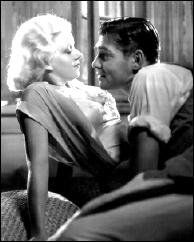
All things considered, one things a movie fan might ask for is a film that is entertaining all the way through, and well made as well. Here’s one, and isn’t it hard to believe that this picture is almost [80] years old?
It takes place on a rubber plantation, with Clark Gable in charge of operations. Jean Harlow is a brassy blonde tramp who needs a few weeks away from Saigon, where things have gotten a little too hot for her.
Gene Raymond is a naive young engineer just hired to do some surveying and irrigation work. Mary Astor is his wife, who has come along with him without realizing how primitive conditions would be.
Jean Harlow falls in love with Clark Gable, who finds Mary Astor more attractive than he should. Raymond, well, as I said, he’s young and naive. The movie is funny, steamy, and fascinating, all rolled into one.
I may have mentioned before that I sometimes find Clark Gable’s performances a little too slick for my tastes, but he’s down-to-earth (if not outright earthy) in this film. Jean Harlow was pretty without being beautiful, but she also had a raucous sense of humor that goes well here with her portrayal of a pretty loose woman. A more terrifically matched couple you couldn’t imagine.
— Reprinted from Mystery*File 33, September 1991 (slightly revised).
Next Page »






